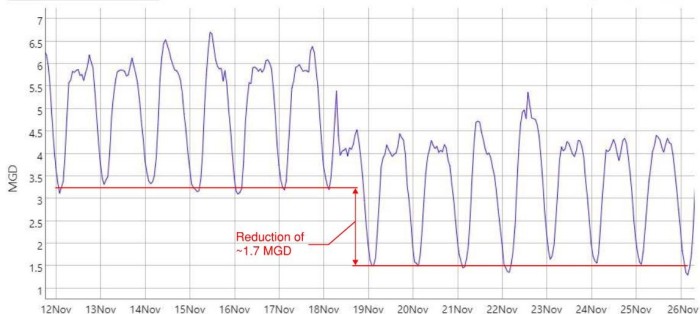The Mystery of the Missing Water
Posted on February 26, 2021
In early august, the City of Roseville detected an anomaly in their water consumption. On August 6, 2020 there appeared to be a significant increase in the City’s flow rate. The below graph illustrates how the City’s daily pattern of water consumption shifted upwards by approximately 1.5 million gallons per day (MGD). For perspective, the average person uses roughly 100 gallons per day or 36,500 gallons per year.

At approximately 5:30 a.m., the base water consumption suddenly jumped from about 2.7 MGD to 4.2 MGD, a 55% increase. It was immediately clear that the team had to identify what was responsible for this extra water.
The first task was a review of the city’s customer water billings to see if a resident or business had a sudden increase in water use. The amount of water flowing into a city that does not get billed to the city’s customers is known as Water Loss. Unfortunately, the search didn’t come up with anything unusual, meaning the city was responsible for the entire cost of the missing water. In this case, the cost of the water loss was in the ballpark of $1,200 per day.
Since customer usage was ruled out, the number one suspect was a major water main break. However, there was no evidence or reports of groundwater flowing to the surface, especially in the amount expected, so it was assumed that the water must be travelling underground into a nearby sewer. When this happens, the water can carry away soil particles, creating large underground voids. Since many water mains run near or beneath roads and sidewalks, these voids are a major safety concern.
The team took a number of different approaches trying to find the suspected water main break. We looked through sanitary sewer and combined sewer flow data hoping to see a similar increase in sewer flow rates, but the results were inconclusive.
AEW and the City of Roseville coordinated to investigate the City’s storm sewer outlets one by one, hoping to see the large volume of water dumping into a river or drain. If flow was discovered in a storm sewer outlet during dry weather, it would allow us to narrow down the area of the suspected water main break and trace the flow back to the exact location. Once again, the search didn’t produce any evidence.
A shutdown of one of the city’s water sources was performed, in hopes that the flow meters would respond in a way to indicate they weren’t within calibration. This was also ruled out when the other water source’s flow rate just increased accordingly.
As these approaches failed to produce results, the team turned to an outside company to perform leak detection services throughout the water system. Leak detection involves specialized equipment that uses a probe to listen to the ground surface. The sound is amplified to allow the operator to detect noises deep beneath the ground surface. The process involves an operator tracing the path of the water main until any underground, running water is discovered.
Finally, on November 18, 2020, the leak detectors discovered exactly what we were looking for. The picture below shows what the crews saw once the pavement was removed.

A roughly 70-year-old, 8-inch diameter, cast iron water main had failed catastrophically. The failure was located directly beneath an intersection in a residential neighborhood. A large hole burst through the underside of the water main, forcing pressurized water downward. The high flow rate gouged a large void in the soil beneath the water main. The void also undermined the adjacent storm sewer causing it to collapse. The collapse left a large opening for the water to flow into the sewer without reaching the ground surface. The below video shows the water flowing into the catch basin through the collapsed storm sewer. When you see the intensity of the flow, it’s easy to imagine how the water could gouge an enormous hole in the surrounding soil.
The below picture shows the city crews repairing the collapsed storm sewer.

At the time the break was discovered, the void was over 10 feet deep. You can see how large the void became. The soil shown was not excavated by the city crews. The hole was entirely created by the flow from the water main break. The depth is even greater than the picture implies because the city had to dump gravel in the hole in order to work on the damage. When you consider that the entire space was a void beneath the pavement, it is easy to understand how hazardous water main breaks can become.
Once the repair was made, the city’s flow rates were immediately corrected. But there was an unexpected benefit that was noticed. The average flow rates after the repair was made, were lower than the flow rates before the break was discovered! This amounted to a decrease of about 1.7 MGD.

One possible explanation could be that there was a leak or small break in the water main that went undetected until it suddenly broke open the morning of August 6. There’s also no telling exactly how long the leak would have been active, and if the leak had not suddenly broken open, it’s possible that it could’ve continued leaking indefinitely. Thanks to the repair that was made on November 18, the city is now saving 200,000 gallons every day that might not have been found without the major break.
This story is a perfect illustration of the creativity and teamwork that goes into solving unique problems alongside our clients and communities. The City of Roseville’s response to this water main break should serve as a shining example for other communities of how to react in order to keep its residents safe. Thanks to these efforts and the success of the leak detection operations in combination with its cost efficiency, we’ve begun to recommend leak detection throughout our communities to help identify sources of water loss and save money for our clients and their residents.

Ross Wilberding, Engineering
Born and raised in southeast Michigan, Ross graduated from U of M in 2014 where he studied Civil Engineering with a background in Hydraulics and Hydrology. Ross currently specializes in general-civil and municipal engineering projects, and is heavily involved in project management. Obtaining his professional engineering license in 2019, Ross’ experience ranges from water reliability and hydraulic/hydrologic studies to infrastructure design of sewers, water mains, pressure reducing valve stations, and roads. In the limited time that he isn’t working on his house, Ross spends as much time as possible up north or on the water. Ross enjoys outdoor activities like golfing, fishing, boating, and skiing. He also enjoys playing sports like hockey and tennis while he still can. Outside of his amateur athletic ambitions he’s also a passionate fan of local college and professional sports.
